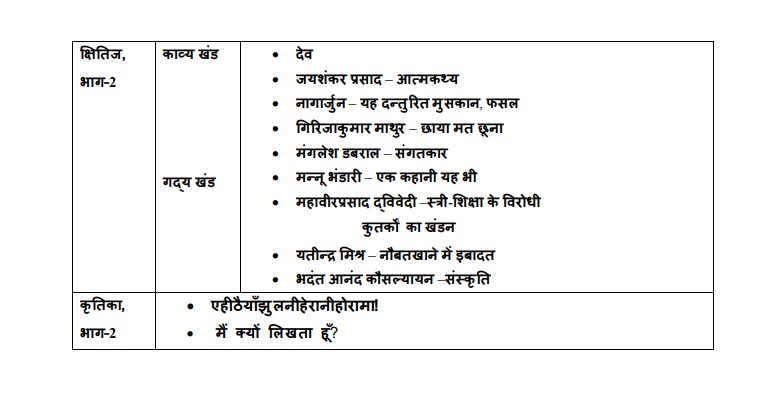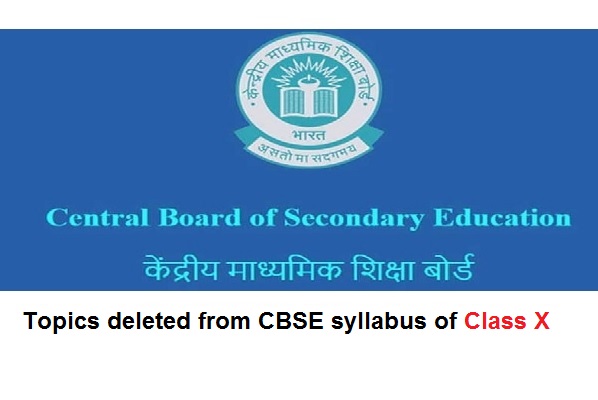The prevailing health emergency in the country and at different parts of the world as well as the efforts to contain the spread of Covid-19 pandemic has resulted in loss of class room teaching due to closure of schools. Therefore the Board has decided to revise the syllabi for classes IX-XII for the academic session 2020-21.
The Heads of Schools and Teachers may ensure that the topics that have been reduced are also explained to the students to the extent required to connect different topics. However the reduced syllabus will not be part of the topics for Internal Assessment and year-end Board Examination.
The deleted topics are as under:
1. Computer Application:
A. Scratch or Python (Unit-4)
Alternative 1: Scratch
- Revision of the basics of Scratch
- Sprite, tempo, variables, and events
- Coordinates and conditionals
- Drawing with iteration
- Update variables repeatedly, iterative development, ask and answer blocks
- Create games, animated images, stories and songs
OR
Alternative 2: Python
- Revision of Python basics
- Conditionals: if, if-else statements
- Loops: for, while (e.g., sum of first 10 natural numbers)
- Practice simple programs
NOTE: In the same sequence, Python programs removed from the Practical syllabus of 10th class.
2. English - Language and Literature:
A. Grammar
- Use of Passive Voice
- Clauses: Noun, Adverb Clauses of condition and time, Relative
- Prepositions
- FIRST FLIGHT – Text for Class X
B. Literature
i. FIRST FLIGHT
- How to Tell Wild Animals
- Trees
- Fog
- Mijbil the Otter
- For Anne Gregory
ii. FOOTPRINTS WITHOUT FEET
- The Midnight Visitor
- A Question of Trust
- The Book That Saved The Earth
3. Hindi-A

4. Hindi-B

5. Home Science
A. Human growth &development II (Unit-I)
- Problems of adolescents
B. Management of Resources: Time, Energy and Money (Unit-II)
- Family Income
C. Food Safety and Consumer Education (Unit-V)
- Consumer Education
D. Care and Maintenance of Fabrics and Apparel (Unit-VI)
- Readymade Garments
6. Mathematics:
A. Number Systems (Unit-I)
i. Real Numbers
- Euclid’s division lemma
B. Algebra (Unit-II)
i. Polynomials
- Statement and simple problems on division algorithm for polynomials with real coefficients
ii. Pair of Linear Equations in Two Variables
- cross multiplication method
iii. Quadratic Equations
- Situational problems based on equations reducible to quadratic equations
iv. Arithmetic Progressions
- Application in solving daily life problems based on sum to n terms
C. Coordinate Geometry (Unit-III)
i. Coordinate Geometry
- Area of a triangle
D. Geometry (Unit-IV)
i. Triangles
- Proof of the theorem: The ratio of the areas of two similar triangles is equal to the ratio of the squares of their corresponding sides.
- Proof of the theorem: In a triangle, if the square on one side is equal to sum of the squares on the other two sides, the angle opposite to the first side is a right angle.
ii. Constructions
- Construction of a triangle similar to a given triangle
E. Trigonometry (Unit-V)
i. Introduction to Trigonometry
- motivate the ratios whichever are defined at 0o and 90o
ii. Trigonometric Identities
- Trigonometric ratios of complementary angles
F. Mensuration (Unit-VI)
i. Areas Related to Circles
- Problems on central angle of 120°
ii. Surface Areas and Volumes
- Frustum of a cone
G. Statistics & Probability (Unit-VII)
i. Statistics
- Step deviation Method for finding the mean
- Cumulative Frequency graph
7. Science
A. Chemical Substances - Nature and Behaviour (Unit-I)
i. Metals and Non-metals:
- Basic Metallurgical processes
- Corrosion and its prevention
ii. Carbon and its Compounds:
- Nomenclature of carbon compounds containing functional groups (halogens, alcohol, ketones, aldehydes, alkanes and alkynes), difference between saturated hydro carbons and unsaturated hydrocarbons.
- Chemical properties of carbon compounds (combustion, oxidation, addition and substitution reaction).
- Ethanol and Ethanoic acid (only properties and uses), soaps and detergents.
B. World of Living (Unit-II)
i. Control and co-ordination in animals and plants:
- Tropic movements in plants
- Introduction of plant hormones
ii. Control and co-ordination in animals
- Nervous system
- Voluntary, involuntary and reflex action
iii. Chemical co-ordination
- animal hormones.
iv. Heredity and Evolution:
- Basic concepts of evolution
C. Natural Phenomena (Unit-III)
i. The Human Eye and the Colourful World:
- Functioning of a lens in Human eye, defects of vision and their corrections, applications of spherical mirrors and lenses
D. Effects of Current (Unit-IV)
i. Magnetic Effects of Electric Current:
- Electric Generator, Direct current.
ii. Alternating current:
- Frequency of AC.
- Advantage of AC over DC.
iii. Domestic electric circuits.
E. Natural Resources (Unit-V)
i. Sources of energy:
- Different forms of energy, conventional and nonconventional sources of energy
- Fossil fuels, solar energy;
- biogas;
- wind, water and tidal energy;
- Nuclear energy.
- Renewable versus non-renewable sources of energy.
F. Deleted Practicals
- Finding the pH of the following samples by using pH paper/universal indicator:
- Dilute Hydrochloric Acid
- Dilute NaOH solution
- Dilute Ethanoic Acid solution
- Lemon juice
- Water
- Dilute Hydrogen Carbonate solution
- Determination of the equivalent resistance of two resistors when connected in series and parallel.
- Preparing a temporary mount of a leaf peel to show stomata.
- Study of the following properties of acetic acid (ethanoic acid):
- Odour
- solubility in water
- effect on litmus
- reaction with Sodium Hydrogen Carbonate
- Study of the comparative cleaning capacity of a sample of soap in soft and hard water.
- Finding the image distance for varying object distances in case of a convex lens and drawing corresponding ray diagrams to show the nature of image formed.
- Identification of the different parts of an embryo of a dicot seed (Pea, gram or red kidney bean).
G: Internal Assessment
i. Management of natural resources:
- Conservation and judicious use of natural resources.
- Forest and wild life
- Coal and Petroleum conservation.
- Examples of people’s participation for conservation of natural resources.
- Big dams: advantages and limitations; alternatives, if any.
- Water harvesting.
- Sustainability of natural resources.
8. Social Science
A. India and The Contemporary World – II (History) (Unit-1)
i. Section 2: Livelihoods, Economies and Societies
- Chapter IV: Forest Society and Colonialism (The chosen Chapter to be assessed in the Periodic Tests and not in Board Examination)
- Chapter V: Pastoralists in the Modern World (The chosen Chapter to be assessed in the Periodic Tests and not in Board Examination)
- Section 3: Everyday Life, Culture and Politics (Complete Chapter)
- Chapter 5: Print Culture and the Modern World (Complete Chapter)
B. Contemporary India – Ii (Geography) (Unit-2)
i. Chapter 2: Forest and Wildlife (Complete Chapter)
ii. Chapter 3: Water Resources (Complete Chapter except for Map Items which will be assessed in the Examination)
iii. Chapter 5: Mineral and Energy Resources (Complete Chapter except for Map Items which will be assessed in the Examination)
C. Democratic Politics –Ii (Political Science) (Unit-3)
i. Chapter 3: Democracy and Diversity (Complete Chapter)
ii. Chapter 4: Gender, Religion and Caste (Complete Chapter)
iii. Chapter 5: Popular Struggles and Movements (Complete Chapter)
iv. Chapter 8: Challenges to Democracy (Complete Chapter)
(Also read: CBSE deleted certain topics from syllabus for session 2020-21)
(Also read: Safety tips for your Credit Card)
(Also read: Mild or medium color blind person will also get Driving License now)
(Also read: Muslims from India will not go to Saudi Arabia to perform Haj 2020)
(Also read: Government made available Sanitary Napkins for Rs. 1 only)
Disclaimer: The above post includes some content used from CBSE website and executed on this website for fair use only. As this website is of educational nature, hence the content is used for education and awareness to the public.

